RCA Building

Mr. Weissberg realized office buildings were far more profitable than apartments, so that became his focus. Office buildings for government and corporate tenants.
Mr. Marvin Weissberg was a commercial real estate broker and developer from Washington D.C. He started his business with his brother in 1955, when, realizing the potential for development there, they opened a small office across the river in Arlington, near the Courthouse.
In the 1950s, Rosslyn was a completely different place from the urban, sophisticated high-rise anchor of the Rosslyn-Ballston Metro corridor that it is today. At that time, Rosslyn was more industrial. There were lumber yards, cement, asphalt, and concrete mixing plants, coal yards, huge fuel oil and gasoline storage tanks, piers, and wharves for river shipping. Rosslyn also had construction businesses, plumbing supply houses, auto repair shops, pawn shops, a brewery, and a lot of old, run-down, dilapidated buildings.
In the 1950s the Arlington County Board became interested in what was then popularly known as “urban renewal,” a process and practice of large-scale demolition of old businesses and operations and building new modern structures in their place. The Board tried a bond issuance to fund urban renewal but it was voted down. So the Board went directly to developers, to assess their willingness to put their own money down to pay for such re-development.
Mr. Weissberg was among those who were first approached. He sensed the big changes coming to that particular area: with the construction of the Theodore Roosevelt bridge, connecting Rosslyn directly to Constitution Avenue in D.C.; and the first section of Route 66, in Rosslyn, being planned. The old street car and rail lines had been removed, and busses were becoming the preferred mode of public transportation, with the Key Bridge connecting Arlington to D.C., for easier, faster, more direct commuting.
The State Department was also searching for space in Virginia to build a language training school, and they initially located in an unused garage space for the Arlington Towers apartments complex in Rosslyn.
The County Board started seeking out individual developers and companies to revitalize Rosslyn. Among them was the Pomponio Company, which was building low-rise apartments in Arlington and up and down the East Coast.
Mr. Weissberg opened the door for the Gould and Smith Company, a large developer from New York. They went out and sought investors to buy the American Oil (AMOCO) property, which was located adjacent, to the south of the Route-66 right-of-way, and Lee Highway. Most of the financial backing came from Mr. Kingdon Gould, a wealthy D.C. investor. Mr. Weissberg secured this initial financing for the construction of commercial office space, which was deemed more profitable than residential apartment buildings.
There was also impetus from the Federal government, which found property costs to be much lower than in D.C., and they were interested in office space for government workers. Rents were lower in Virginia, and there was plenty of space for parking. Plus the bus lines and connections. They found Rosslyn perfect for new buildings and construction. So Mr. Weissberg began to plan office buildings, rather than residential, in Rosslyn. Mr. Weissberg realized office buildings were far more profitable than apartments, so that became his focus. Office buildings for government and corporate tenants.
The County was also interested in office buildings, because they generated tax revenues, but had a much lower demand for services. Subsequently, the County changed the zoning in Rosslyn from industrial and light industry to commercial office, and in so doing, removed the previous height restrictions from 3-story buildings, and changed it to 12 stories.
Mr. Weissberg, with financing in hand, and County zoning regulations changed, then began construction on a 12-story commercial office building at the intersection of North 19th and Moore Streets in Rosslyn, bordered on the north by Lee Highway, and N. Lynn St, on the east side. It was completed in 1956 and was the first high-rise office building in Arlington. When completed, the first tenant to lease space was the RCA (Radio Corporation of America) company. RCA paid to have large red letters, 9 feet tall, installed at the top of the building, on the sides facing D.C., highly visible across the river, and illuminated at night. Thus, it soon became known as “The RCA building.”
Other high-profile corporate tenants followed, including the Bendix Corp, Xerox, Northwest Mutual Insurance, and Lockheed Martin.
The timing was right in other ways since this is when corporate America started to adopt the use of large, mainframe computers, mostly from IBM. RCA wanted a special space created, with proper temperature and air conditioning, to manage what was envisioned as the RCA computing center for the entire company. This was the beginning of a new high-tech age, a first for Arlington. Soon, other tenants arrived in Rosslyn, like the Defense Advanced Research Projects Agency (DARPA), a unit of the Department of Defense, which put its headquarters in another new high-rise office building a couple blocks away from the RCA building.
As a result, Rosslyn started to become a whole new financial engine for the County, generating huge tax revenues, at low cost for services.
Sources:
Interview Transcript, Arlington Department of Libraries, Mr. Marvin Weissberg, November 17, 2016
In-person interview with Mr. Marvin Weissberg, March, 2019, by the author.
Images


